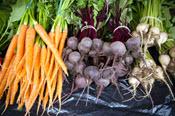
Unlocking the growth of Ontario’s local food sector
by Jim Algie
Systemic barriers remain to the full development of Ontario’s local food potential, several observers say.
Barriers highlighted during a series of recent Better Farming interviews include: challenges of access to capital, lack of co-ordinated distribution and the centralized purchasing habits of large, institutional food buyers such as hospitals.
Commercial retail chains have begun actively promoting local food, adding competition to small-scale developments in retail and wholesale distribution that characterized local food in its earliest stages.
In June, Metro Ontario announced the fourth in a series of regional purchasing policies. Since 2017, the company has introduced over 400 local products to its stores.
Also in June, Loblaws announced a $150-million annual spending target by 2025 to replace imports with fresh, local produce.

laughingmango/iStock/Getty Images Plus photo
At the same time, signs exist that some smaller, local food retailers have struggled. The West End Food Coop in downtown Toronto, for example, recently closed its retail store because of the challenge of big city rents. Eat Local, a Sudbury-based distributor announced earlier this year that it would close because of persistent financial trouble.
But competition is not the problem, said Sally Miller, a long-time local food organizer. She is project manager for the province-wide Local Food and Farm Co-ops that has announced a new local food financial fund.
“Honestly, I think that’s what we want,” she said to Better Farming. “We want (local food) everywhere; that’s what’s going to make it work for producers of every size.
“I think there was some pressure, some of it coming from, I think, so many actors getting into local food,” Miller said. “It was bound to cause some challenges.”
However, she cites continuing awareness and interest from the public and farmers in the expansion of local food production and distribution systems.
“I think one of the main things that’s missing right now is a lot of the mid-scale processing. There’s sort of a disconnect between large-scale organizations trying to do local food and just the level of supply and the distribution networks and the processing. That needs to be rebuilt,” Miller said.
Thorsten Arnold, the general manager of Eat Local Grey Bruce, a successful co-operative for consumers and producers in Owen Sound, described the need for better co-ordination both of government grant procedures and wholesale food distribution. He is particularly interested in supporting small-scale farmers with demonstrated contributions to local rural economies, the environment and food quality.
“I think that government has learned some lessons in the first part of its local food fund,” said Arnold. He works with his wife, Kristine Hammel, at Persephone Market Garden west of Owen Sound and recently joined the staff of the Ecological Farmers of Ontario. The government needs to broaden its approach, Arnold said.
“We’re working incrementally one project at a time, very short in duration and fairly small in financial terms,” he said. “We’re increasingly running into these more systemic barriers that require orchestrated solutions.”
Alison Blay-Palmer, who heads Wilfrid Laurier University’s Centre for Sustainable Food Systems, figures more needs to be done to improve market recognition of small-scale farmers who provide social and environmental benefits for their communities.
“I don’t think we’ve cracked the nut as well as we could have,” Blay-Palmer said.
“Sort of the motivation for the Local Food Act was to try and use public procurement on the demand side based on purchasing power of government institutions to provide a stable market for local food in Ontario and that really hasn’t happened.
“There has to be a recognition that this is a different kind of food system if we’re going to do local food,” Blay-Palmer said, highlighting the rural economic development, environmental and health benefits of local food.
“I think there’s lots of opportunity to make this more of a thing than it is now.” BF



Post new comment